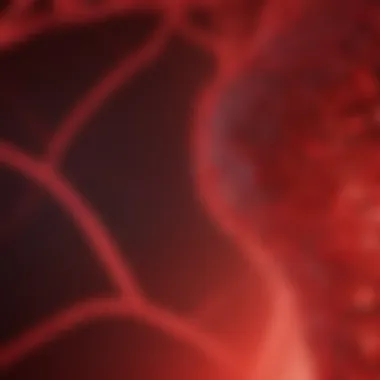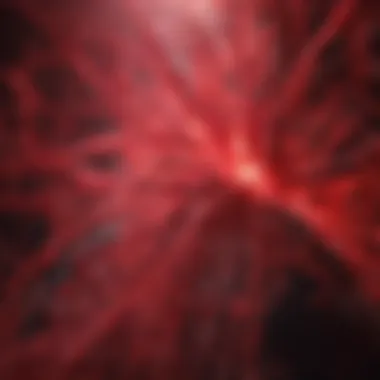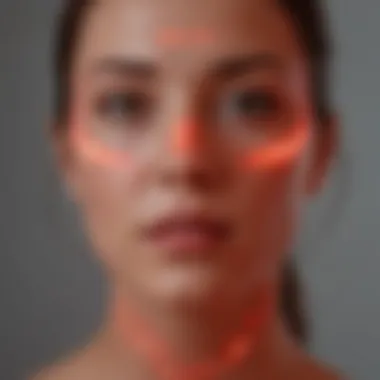Insights into ATP Red Light Therapy Mechanisms


Intro
ATP red light therapy is gaining traction, bringing together elements of light science and cellular respiration. This concept might sound like something straight out of a laboratory textbook, but its implications reach far beyond the realm of academics. By understanding how specific wavelengths of light can affect cellular mechanisms, particularly the production of adenosine triphosphate (ATP), we can unlock potential benefits in health, wellness, and even athletic performance.
When we say ATP, we're referring to that little power pack—and by little, I mean crucial—that fuels our cells. Think of it as the battery that keeps everything running. Without ATP, our cells wouldn't be able to perform the myriad tasks they're designed for. The incorporation of red light therapy into this equation is nothing short of innovative, providing a fresh lens through which we can understand how we might leverage light to enhance our body’s natural processes.
In this article, we'll unpack the complexities surrounding ATP red light therapy. It’s not just about shining some lights and calling it a day. From its scientific bedrock to advancements in the field, we're diving deep to make sense of how it all comes together and what it means for those looking to optimize their health or improve recovery in sports.
Moreover, we'll take a stroll through recent research trends. These are exciting times, with studies yielding significant insights into cellular mechanisms and therapeutic uses, demonstrating how ATP red light therapy might play a pivotal role in various settings.
Preface to ATP Red Light Therapy
The realm of ATP red light therapy opens a window into the intricate dance between energy and cellular function. This therapy, which leverages specific light wavelengths to enhance ATP production, plays a crucial role in maintaining optimal health and wellness. By delving into its mechanisms and applications, we begin to uncover how light can transform the way we manage various health conditions.
In today's world, where the quest for non-invasive treatment methods is paramount, understanding ATP red light therapy becomes essential. Its applications span a variety of fields, particularly sports medicine, dermatology, and rehabilitation. Recognizing how red light exposure encourages cellular repair and energy production enables not only a better appreciation of this therapy but also informs healthcare practitioners and patients alike about integrating it into their health routines.
Defining ATP and Its Role in Cellular Function
ATP, or adenosine triphosphate, is often labeled the energy currency of the cell. It’s like the gas that fuels our body's engine, powering numerous biochemical reactions essential for life. Without ATP, our cells would face the debilitating effects of energy depletion, halting processes critical for growth, repair, and metabolic functions.
In a nutshell, ATP is synthesized mainly in the mitochondria—the powerhouse of the cell. Factors like stress, environmental toxins, and aging can negatively impact ATP levels, leading to reduced cellular efficiency. It's not an exaggeration to say that maintaining healthy ATP levels directly correlates to overall well-being, making its enhancement through therapies like red light intriguing. As such, improvements in ATP production could translate to increased energy levels and better recovery from injuries, which is especially relevant in sports and active lifestyles.
Overview of Photobiomodulation
Photobiomodulation (PBM) refers to the process where specific light wavelengths interact with biological tissues, leading to beneficial physiological changes. This process harnesses the energy of light—primarily in the red and near-infrared spectrum—to stimulate a cascade of cellular responses.
Understanding PBM opens pathways to a plethora of potential applications. The primary mechanism involves the absorption of light by chromophores in the cells, which subsequently enhances mitochondrial activity and promotes ATP synthesis. As a result, practitioners can use PBM to address a variety of health issues, from chronic pain to skin rejuvenation. When applied effectively, photobiomodulation can elevate local tissue healing processes, reduce inflammation, and improve circulation—all fundamental elements in optimal health.
"Research indicates that photobiomodulation can lead to marked improvements in cellular metabolism and tissue repair, proving its relevance across medical disciplines."
"Research indicates that photobiomodulation can lead to marked improvements in cellular metabolism and tissue repair, proving its relevance across medical disciplines."
Mechanisms of Action
When it comes to ATP red light therapy, the mechanisms of action play a pivotal role. This topic not only embodies the science behind the therapy but also propounds its real-world applications, understanding the intricate workings at a cellular level. By exploring these mechanisms, we can discern how red light serves as a catalyst for various therapeutic effects, enhancing cellular performance while contributing to overall well-being. The investigation into these mechanisms allows for a deeper appreciation of the potential benefits, limitations, and areas of controversy surrounding this innovative therapy.
Interaction of Light with Biological Tissue
The interaction of light with biological tissue reflects a sophisticated yet straightforward principle. When red light is applied, it penetrates various layers of the skin and underlying tissues. This is often attributed to the unique wavelengths in the spectrum, typically ranging from 600 to 1000 nanometers. These specific frequencies are absorbed by chromophores found within cells, which are biomolecules that can absorb light.
This absorption triggers responses within the autoimmune system and can stimulate processes such as vasodilation. That’s when blood vessels widen, leading to better oxygen and nutrient delivery to the treated areas. By facilitating such processes, the light becomes not just a source of energy but also a means of signaling critical biochemical pathways.
Moreover, the intensity and duration of light exposure are vital factors. Too low an intensity might not yield significant results, while extremes can cause more harm than good. Hence, understanding how various types of tissues react distinctly to light is essential—muscle tissue may behave quite differently from skin or nerve tissue in response to such therapy.
ATP Production: Biochemical Pathways
ATP production through biochemical pathways is another foundational aspect of ATP red light therapy. At the heart of this process lies the mitochondria, often dubbed the powerhouse of the cell. When red light penetrates the cellular structure, it influences mitochondrial activity, promoting the conversion of adenosine diphosphate (ADP) back to ATP. This conversion is crucial as ATP is the primary energy currency that powers almost every function of the cell.


Red light therapy encourages enhanced cellular respiration and greater ATP synthesis by increasing cytochrome c oxidase activity within the mitochondria. This metabolic boost can enhance recovery in damaged tissues, accelerate healing, and improve overall cell function. As a product of improved ATP production, cellular energy levels rise, which translates to enhanced performance not just at a cellular level but, eventually, at whole-body levels as well.
Role of Mitochondria in Light Absorption
Mitochondria play a central role in how cells absorb light, leading to a cascade of beneficial biological reactions. These organelles are structured to capture light energy effectively, particularly at red and near-infrared wavelengths. More than just simple energy producers, mitochondria are involved in various signaling pathways and have a hand in regulating the metabolic processes within the cell.
The optimal absorption of light by mitochondria not only decreases oxidative stress by facilitating the creation of reactive oxygen species but also promotes cellular repair processes. By enhancing mitochondrial function through red light exposure, there is potential for improved energy metabolism and reduced levels of cellular fatigue. Furthermore, studies reveal that efficient light absorption within these organelles may also stimulate the production of antioxidant enzymes, fortifying the cell's defense mechanisms against stress.
"Understanding how light influences cellular processes opens avenues for revolutionizing treatments across various healthcare fields."
"Understanding how light influences cellular processes opens avenues for revolutionizing treatments across various healthcare fields."
Health Benefits of ATP Red Light Therapy
The scope of ATP red light therapy extends far beyond its scientific context, delving into its tangible health benefits. It stands as a promising avenue for those seeking holistic solutions in various domains, especially in sports medicine, aesthetic enhancements, and addressing pain management. The interplay of light and biology isn’t just a scientific curiosity; it’s a beacon of hope for many.
Applications in Sports Medicine
In the high-stakes arena of sports medicine, ATP red light therapy is increasingly being recognized as a game-changer. Athletes are no strangers to rigorous training and the inevitable wear and tear that follows. Here, the therapy plays a pivotal role in both recovery and performance enhancement.
- Faster Recovery: The therapy aids in speeding up recovery from injuries by facilitating ATP production. Increased ATP levels can lead to improved cellular repair and regeneration, allowing athletes to get back into the action sooner.
- Enhanced Performance: Studies suggest that pre-competition exposure to red light therapy might improve muscular endurance, potentially allowing athletes to push their limits with less fatigue.
- Reduced Muscle Soreness: Post-exercise muscle soreness can be a significant hurdle for athletes. Utilization of ATP red light therapy can minimize delayed onset muscle soreness (DOMS), enabling quicker recovery times and more effective training cycles.
This therapy seems to provide that extra edge athletes dream of. As they push their bodies, the support of ATP red light therapy can be the fine line between dealing with pain and pushing through it.
Skin Health and Aesthetic Uses
The aesthetic world has paid keen attention to the advantages of ATP red light therapy for skin health. From anti-aging strategies to wound healing, its applications are diverse and potent. The therapy promotes several positive outcomes:
- Collagen Production: One of the most celebrated benefits is its ability to stimulate collagen and elastin production, essential for maintaining youthful skin. This is significant for those aiming to reduce the appearance of fine lines and wrinkles.
- Wound Healing: Post-surgical or accident-related wounds can benefit from accelerated healing due to improved cellular function within the dermal tissue, significantly reducing the scar formation.
- Anti-inflammatory Effects: Conditions like acne or rosacea can see improvements as the therapy addresses inflammation, reducing redness and irritation on the skin.
The advancement of beauty treatments is seeing this technology flourish, with many spas and clinics now offering it as part of their services. People are beginning to realize that achieving healthy skin may very well lie in harnessing light.
Pain Management and Inflammation Reduction
Pain can be a relentless foe for many individuals, from chronic conditions to acute injuries. ATP red light therapy emerges as a potential partner in mitigating such challenges, complementing existing pain relief methods. Significant points include:
- Decreased Pain Levels: By promoting better circulation and reducing inflammation at the cellular level, patients often report lower pain levels after treatments.
- Decreased Inflammation: Inflammatory markers can be greatly reduced with consistent therapy, aiding those experiencing conditions like arthritis or tendonitis.
- Non-Invasive Option: One of the most appealing aspects is the non-invasive nature of the therapy. For many, the thought of easing pain without resorting to pharmaceuticals is a major selling point.
This therapy bridges gaps that traditional pain management strategies may not cover, creating pathways for healing that prioritize a person’s overall well-being.
"Health isn't just the absence of disease; it's a dynamic state of well-being influenced by every choice we make. Red light therapy is paving the way to redefine how we approach healing and performance."
"Health isn't just the absence of disease; it's a dynamic state of well-being influenced by every choice we make. Red light therapy is paving the way to redefine how we approach healing and performance."
The health benefits of ATP red light therapy are expansive, touching countless lives by enhancing recovery, promoting healthy skin, and alleviating pain. As more research unfolds and understanding deepens, the significance of this therapy becomes ever more evident, solidifying its role as a viable option in modern health practices.
Scientific Research Supporting Red Light Therapy
The growing field of ATP red light therapy has captured the attention of many researchers. This section dives into the scientific foundation underpinning this approach, examining how clinical trials and systematic investigations validate its efficacy for various applications. By understanding the rigorous research supporting this therapy, readers gain insight into its therapeutic potential and the practical implications for health and wellness.


Clinical Trials and Their Findings
Clinical trials offer concrete data regarding the effectiveness of ATP red light therapy. Numerous studies have tested its impact across diverse conditions, ranging from injury recovery to skin rejuvenation. For example, a randomized controlled trial conducted on participants with osteoarthritis demonstrated significant pain reduction when using red light therapy compared to a placebo. Such studies illuminate the practical benefits, giving credence to its application in multiple therapeutic contexts.
Moreover, the results are not just anecdotal. They are often backed by metrics such as reduced inflammation markers and enhanced tissue repair rates. This encourages further exploration around patient-specific outcomes.
Key points from various clinical trials include:
- Enhanced muscle recovery and performance in athletes
- Improvement in skin elasticity and reduction of wrinkles
- Notable reductions in chronic pain conditions, like back pain and fibromyalgia
- Faster healing times post-surgery or injury
Moreover, large sample sizes and multi-center studies amplify these findings. They underline a consistent trend throughout various demographics and health conditions. Hence, the evidence strongly supports the use of ATP red light therapy as a complementary treatment in several fields.
Meta-Analyses and Systematic Reviews
While individual studies provide insights, meta-analyses and systematic reviews draw a broader picture, consolidating various trial results to highlight overarching trends. These comprehensive reviews analyze and synthesize data from multiple studies to arrive at more definitive conclusions regarding the efficacy of ATP red light therapy.
A systematic review published in a prominent journal collated data from over 30 trials regarding the therapy's impact on pain relief. The findings suggested a medium to large effect size, reinforcing the notion that light therapy can serve as an effective adjunct to conventional pain management strategies.
Here are some notable takeaways from current meta-analyses:
- Significant improvements in chronic inflammatory conditions
- Evidence of enhanced mitochondrial function and ATP production in treated cells
- Consistent findings across different wavelengths and exposure durations
These analytical approaches validate the therapeutic credibility of ATP red light therapy by objectively examining a vast body of evidence. They lend weight to its recommendation for various health disciplines while highlighting areas needing future exploration.
Red light therapy, when backed by robust scientific studies, showcases the potential to revolutionize pain management and recovery processes in sports and clinical settings.
Red light therapy, when backed by robust scientific studies, showcases the potential to revolutionize pain management and recovery processes in sports and clinical settings.
The merging of clinical trial results and meta-analyses creates a compelling argument in favor of ATP red light therapy as a practical tool in modern health practices. Understanding this body of research is crucial for educators, students, and professionals aiming to apply this knowledge in real-world settings.
Potential Limitations and Controversies
Delving into ATP red light therapy necessitates a critical understanding of its potential limitations and controversies. While the therapy shows promise, it’s not all sunshine and rainbows. It’s crucial to identify where the therapy might fall short or where debates arise. This understanding not only aids practitioners in their applications but also informs patients and stakeholders about the nuances involved.
Debates in Efficacy and Safety
The efficacy and safety of ATP red light therapy spark significant debate among professionals and researchers. Some studies tout great benefits, linking red light exposure to improved healing time and enhanced performance in sports medicine. But not all findings align, leading to skepticism.
For instance, a key concern lies in how individual responses to the therapy can vary widely. Factors like skin type, underlying health issues, and even age might influence outcomes. As with any treatment, potential adverse effects loom—skin irritation or exaggerated responses to light exposure can deter some participants.
"Just because a treatment works for one person doesn't mean it will work for another; individual biology is complex and unpredictable."
"Just because a treatment works for one person doesn't mean it will work for another; individual biology is complex and unpredictable."
Moreover, the placebo effect often complicates matters. Positive results observed in clinical trials might not solely stem from the therapy. They could be a product of participants feeling better due to their expectations, not necessarily the light exposure itself. This aspect complicates establishing a universal standard for what constitutes effectiveness. A more cautious approach is vital, along with further rigorous research that delineates where this therapy succeeds and where it might encounter hurdles.
Regulatory and Standardization Issues


Regulatory and standardization issues also add layers of complexity to the landscape of ATP red light therapy. In many parts of the world, devices used for this therapy lack robust regulatory oversight. This absence can lead to a marketplace where varying qualities are in circulation, ultimately confusing users and providers alike.
Inconsistent standards can result in machines that don’t deliver the expected wavelengths or intensities. Such discrepancies can lead to ineffective treatments, potentially causing more harm than good. Without a consistent framework, articulating what constitutes a legitimate and effective ATP red light therapy device becomes a daunting task.
Additionally, the marketing surrounding these devices can often exaggerate capabilities. Some providers may make unsupported claims that mislead potential users about the therapy’s efficacy. Thus, establishing clear guidelines and protocols is pivotal.
These challenges emphasize the need for continued collaboration among researchers, manufacturers, and regulatory bodies to promote a better understanding and utilization of ATP red light therapy, while addressing gaps in knowledge and practice.
Future Directions in ATP Red Light Therapy Research
The subject of ATP red light therapy is expanding and evolving rapidly. As researchers continue to dissect the intricate relationships between light exposure, cellular function, and overall health, the potential applications appear increasingly promising. Understanding the future directions in ATP red light therapy not only sheds light on new avenues for clinical usage but also paves the way for innovative health solutions that may one day be commonplace in therapies. With this article, we delve into both emerging technologies poised to transform the field and the prospect of interdisciplinary collaborations that could further bolster research outcomes.
Emerging Technologies and Innovations
With the scientific community constantly pushing the boundaries of technology, ATP red light therapy is at the forefront of some exciting innovations. These technologies go beyond conventional devices and aim to enhance therapy effectiveness.
- Wearable Devices: Imagine a future where wearable gadgets can administer low-level light therapy seamlessly throughout the day. Such devices could be designed to optimize the timing and dosage of light exposure for maximum ATP production, personalized based on individual skin types or health goals.
- Smartphone Integration: By integrating red light therapy into smartphone apps, individuals could keep track of their light exposure and cellular health. Sensors could measure the effectiveness of the exposure, giving real-time feedback on ATP levels.
- Targeted Delivery Systems: New methods for delivering light therapy directly to affected tissues are being researched. This includes advancements in implantable devices that ensure specific areas receive focused light treatment, thus increasing efficiency and outcomes in various medical conditions.
- Nano-technology: Using nanoparticles as carriers for phototherapeutic agents may revolutionize treatment methods. This targeted approach could amplify the effects of existing therapies or even unlock new treatments for conditions that currently resist standard care.
As these technologies come to fruition, the impact on ATP production and subsequent health benefits could be significant.
Interdisciplinary Studies and Collaborations
The intricate nature of ATP red light therapy calls for interdisciplinary collaboration across various fields, which could play an integral role in advancing our understanding and application of the therapy.
- Biomedical Engineering: By partnering with biomedical engineers, researchers could develop advanced devices that improve the delivery and efficacy of red light therapy. Innovations in optics and materials could yield better results in ATP absorption.
- Clinical Research: Integrating perspectives from clinical researchers allows for robust testing environments that not only validate theoretical benefits, but also assess practical application in real-world settings. This approach could yield substantial insights into viability across different populations.
- Psychology and Wellness Sciences: Studying the psychological impacts of ATP red light therapy can provide comprehensive knowledge about how physical treatments influence mental health. This could enhance the overall therapeutic approach, helping to establish holistic health practices that consider both body and mind.
- Pharmaceutical Sciences: Joining forces with pharmaceutical scientists may lead to the discovery of adjunct therapies that increase the effectiveness of red light therapy. Research into combining low-level laser therapy with specific drugs to enhance ATP production could be enlightening.
Such interdisciplinary efforts can result in a more informed approach to treatment, enriching the understanding of ATP red light therapy and ultimately translating into better health outcomes for patients.
"Interdisciplinary collaboration is the bedrock upon which innovation is built; when diverse minds converge, the possibilities become limitless."
"Interdisciplinary collaboration is the bedrock upon which innovation is built; when diverse minds converge, the possibilities become limitless."
In summary, as research continues to progress, understanding the directions ATP red light therapy can take is vital for stakeholders in health and medical fields. The merging of technology and academic disciplines holds immense potential to unlock enhanced therapeutic options and could redefine how we approach cellular health and overall well-being.
Epilogue
The exploration of ATP red light therapy in this article highlights the convergence of scientific inquiry and practical application. Understanding how specific wavelengths influence cellular metabolism can fundamentally change the way we approach health and wellness. The article discussed several key aspects, each contributing to the broader narrative of ATP's role in vital bodily functions.
Key Takeaways
Reflecting upon our exploration, there are a few points that stand tall:
- Mechanisms of Light Interaction: The way red light interacts with biological tissues opens doors to innovative treatment options. Basic principles of photobiomodulation suggest enhanced ATP production, leading to multifaceted benefits.
- Broad Applications: From sports medicine to dermatology, ATP red light therapy is carving a niche. Each application leverages the scientific groundwork, pushing boundaries of traditional therapies.
- Ongoing Research: The necessity for continuous study is highlighted, especially as technology advances. Keeping abreast of new findings ensures practitioners can provide the best treatments for their patients.
Implications for Future Health Practices
Looking forward, the implications of ATP red light therapy are substantial. As awareness grows, its integration into mainstream healthcare is likely.
- Customized Treatments: Health practitioners might tailor therapies based on individual needs, utilizing red light exposure to optimize cellular function across various populations.
- Preventative Health: Given its ability to promote cellular health, ATP red light therapy could serve as a preventative measure, improving overall wellness rather than merely treating existing conditions.
- Collaborative Efforts: Interdisciplinary studies should be encouraged, as combining insights from various fields can yield richer understandings and broaden applications. Ranging from cellular biology to sports science, collaboration could enhance efficacy.
The ongoing research in ATP red light therapy illustrates that we're merely scratching the surface of its potential. As practitioners and researchers delve deeper, their findings may unravel more of its complexities, ushering in a new era of treatment.
The ongoing research in ATP red light therapy illustrates that we're merely scratching the surface of its potential. As practitioners and researchers delve deeper, their findings may unravel more of its complexities, ushering in a new era of treatment.
In summation, ATP red light therapy embodies a novel approach to health, merging cutting-edge research with tangible results. Its future seems bright, not just for athletes or those seeking beauty treatments, but indeed for anyone interested in enhancing overall health and cellular vitality.







